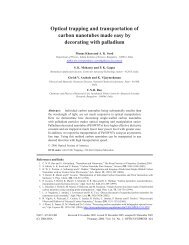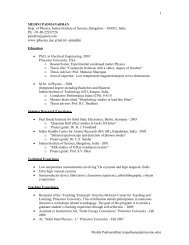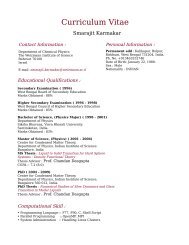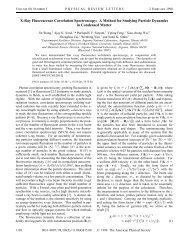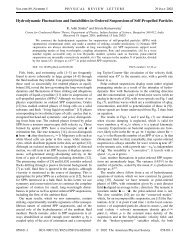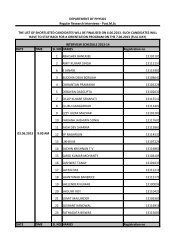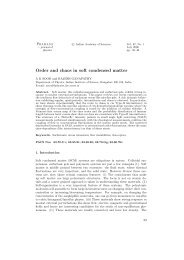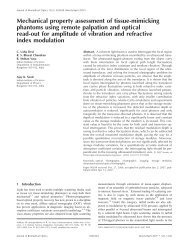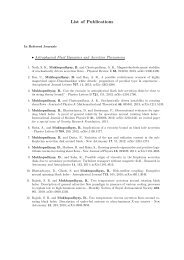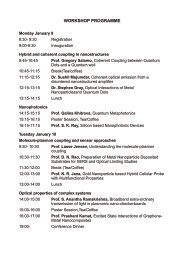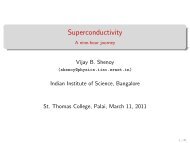Thermoelectric Properties of Fe0.2Co3.8Sb12-xTex ... - Physics
Thermoelectric Properties of Fe0.2Co3.8Sb12-xTex ... - Physics
Thermoelectric Properties of Fe0.2Co3.8Sb12-xTex ... - Physics
Create successful ePaper yourself
Turn your PDF publications into a flip-book with our unique Google optimized e-Paper software.
Confinement <strong>of</strong> Spin Waves in Grids <strong>of</strong> Permalloy Nanowires<br />
D. Venkateswarlu<br />
Department <strong>of</strong> <strong>Physics</strong>, Indian Institute <strong>of</strong> Science, Bangalore 560012, India<br />
Key words—electron beam lithography, shape anisotropy, nanowires, FMR, demagnetization fields, micromagnetics.<br />
Recent advances in magnonics highlight its importance<br />
in microwave frequency applications [1] . This involves the<br />
use <strong>of</strong> spin waves for device applications. Here one needs<br />
to look for better control over the spin waves and their band<br />
structure [2-3] . The periodic variation in the effective<br />
magnetic field in ferromagnetic materials is the basis for<br />
the spin wave confinement and their propagation. Since the<br />
effective field is the combination <strong>of</strong> exchange, external,<br />
anisotropy and demagnetization (dipolar/ stray) fields; one<br />
can achieve the periodic condition in many ways. In our<br />
study, we employed geometry engineering by which the<br />
shape anisotropy was tailored in obtaining the periodicity in<br />
demagnetization fields. S<strong>of</strong>t magnetic material permalloy<br />
(Ni 80 Fe 20 ) was made into grid like structure using a top<br />
down approach.<br />
Ferromagnetic resonance (FMR) measurements give the<br />
information about the non travelling spin waves (k=0<br />
modes). In general, one can see only single resonance<br />
mode in FMR spectra in the case <strong>of</strong> thin films <strong>of</strong> permalloy.<br />
This is due to its weak crystalline anisotropy even in<br />
epitaxial conditions unlike the Fe thin films [4] . When the<br />
permalloy film is made into nanowires with high aspect<br />
ratio, it still gives the single mode but resonance condition<br />
varies with applied field angles. This is due to the fact that<br />
the shape anisotropy governs the condition for resonance.<br />
This advantage <strong>of</strong> the shape anisotropy points towards the<br />
usefulness <strong>of</strong> engineering the network structures.<br />
Fundamentally one needs to understand the dynamics <strong>of</strong><br />
these network structures in order to meet the required<br />
conditions for spin wave band structures in order to use<br />
them in magnonics devices.<br />
The grid structures were fabricated using electron beam<br />
lithography followed by DC magnetron sputtering and lift<strong>of</strong>f<br />
technique. The permalloy deposited on Si wafers was<br />
20nm thick and is capped with 4nm gold to avoid<br />
oxidation. The thickness <strong>of</strong> the deposited materials was<br />
confirmed with the help <strong>of</strong> pre calibrated digital thinness<br />
monitor. The lateral dimensions <strong>of</strong> the grid structures were<br />
obtained using Scanning Electron Microscopy (SEM). The<br />
permalloy wires in the grids found with widths about 140-<br />
160nm. To understand the spin wave confinement effect<br />
we varied the periodicities along horizontal and vertical<br />
directions in the grid: (i) 560x560 (G1), (ii) 800x400 (G2)<br />
and (iii) 1000x500 (G3) (all in nm units).<br />
The FMR spectra on all the three grids were compared<br />
with a reference sample, a continuous thin film grown<br />
under same conditions during the fabrication. The<br />
continuous film showed an uni-axial anisotropy. This was<br />
induced due to the in-situ applied field during the growth.<br />
But the magnitude is very small when compared to that <strong>of</strong><br />
structured samples. The quantitative comparison <strong>of</strong><br />
anisotropy constants was obtained with the help <strong>of</strong> fitting<br />
done with theoretical equations involved in FMR<br />
phenomena.<br />
Two well resolved modes were observed in all three<br />
grids whereas the reference sample gave only one mode.<br />
These two modes corresponds to the spin waves confined<br />
in horizontal and vertical sections <strong>of</strong> the grids. Spin wave<br />
confinement was understood with the help <strong>of</strong> the mode<br />
dependency on the in-plane angle <strong>of</strong> the applied magnetic<br />
field with the grid. There were multiple peaks observed at<br />
some angles in the G2, G3 which is not seen in G1.<br />
The origin for these multiple peaks is understood with<br />
the help <strong>of</strong> static micromagnetic simulations (MMS).<br />
Dynamics <strong>of</strong> G1 using MMS followed by Discrete Fast<br />
Fourier Transformations were used to correlate FMR<br />
spectra. Our simulations methodology gave more insight<br />
into the understanding <strong>of</strong> spin waves confinement. The<br />
implementation <strong>of</strong> 2D-PBC [5] in our MMS made it possible<br />
to study the real systems in realistic time.<br />
Fig.1 Spin wave confinement in the horizontal and vertical<br />
sections <strong>of</strong> the G1.<br />
REFERENCES<br />
[1] V. V. Kruglyak et al., J. Phys. D: Appl. Phys., vol. 43, p.<br />
264001, 2010.<br />
[2] Z. K. Wang et al., Acs Nano, vol. 4, p. 643, 2010.<br />
[3] K. S. Lee et al., Phys. Rev. Lett., v. 102, p. 127202, 2009.<br />
[4] S. Sakshath et al., J. Supercond. Nov. Magn.,<br />
DOI:10.1007/s10948-011-1269-3<br />
[5] D. Venkateswarlu et al., IEEE Trans. Magn., vol. 48, no.<br />
11, Nov. 2012.<br />
FMR experiments were done in collaboration with Pr<strong>of</strong>. S. V. Bhat<br />
D.Venkat@physics.iisc.ernet.in



